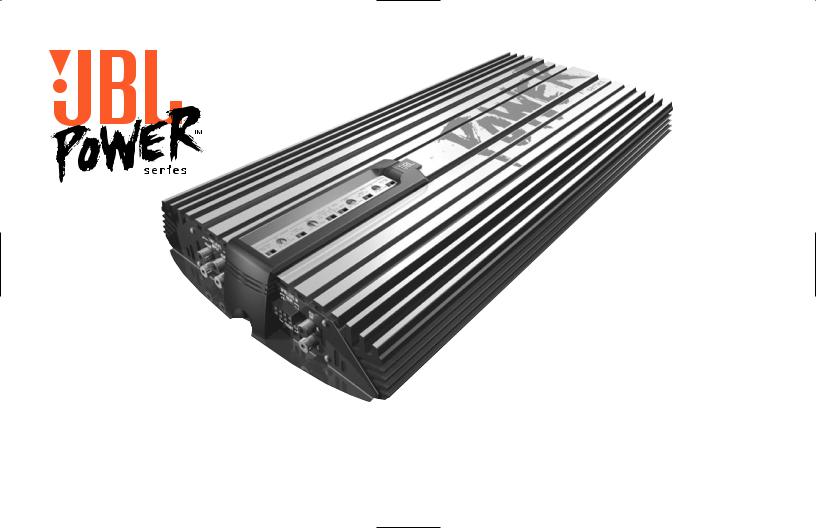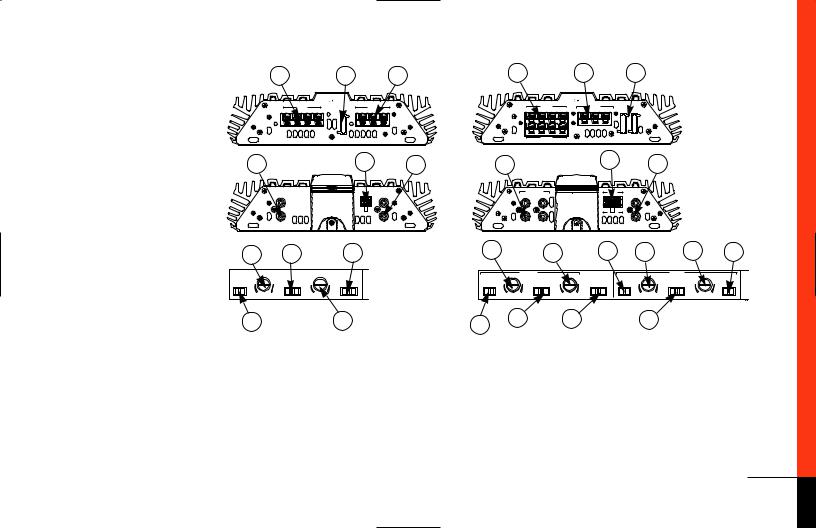JBL P-2510, P-7540, P-7520 User Manual

Power Series Amplifiers
P-7520, P-7540, P-2510 Owner’s Manual
GENUINE JBL

Thank you for purchasing your new JBL Power Series™ amplifier. Power Series amplifiers feature the latest advances in discrete-circuit topology, ensuring low distortion and superbly clean and clear sound quality. In addition to RCA-type pre-amp inputs, Power Series amplifiers feature Universal Interface™, designed to facilitate integration with factory-installed audio systems for distortion-free performance that rivals conventional pre-amp connections. Included in the Universal Interface circuit is Common Sense™ turn-on. Common Sense turn-on senses the common-mode voltage present on the speaker outputs of factory and aftermarket radios, turning on the amplifier without a separate remote wire. All Power Series amplifiers feature built-in electronic crossovers and preamp outputs for easy system expansion without requiring outboard processors.
Amplifier Features
•4-, 3- or 2-channel operation (P-7540), 2- or 1-channel operation (P-7520), mono Class-D subwoofer channel (P-2510)
•Simultaneous stereo and mono operation (P-7520, P-7540)
•Built-in 12dB/oct variable electronic crossover
•Balanced differential input
•Front and rear summing inputs (P-2510) for non-fading bass
•Pre-amp outputs with crossover (P-7520, P-7540)
•Oversized Floating Rail Mosfet Power Supply
•Universal Interface
•Common Sense turn-on
•Variable Input Sensitivity (250mV–4V)
•Fully complementary, direct coupled discrete power amplifier circuitry
•Ultraefficient Class-D subwoofer amplifier (P-2510)
•Gold-plated power, input and output connectors
•2-Ohm stable (stereo)
•JBL badge lights when amp is operating and flashes when protection circuit is activated
•Made in USA
About This Manual
To attain maximum amplifier performance, we encourage you to read the remaining pages before installing and operating your new JBL Power Series amplifier. Especially review the Applications section for ideas on designing and expanding your system. Also, save these instructions for future reference. Important: Installation of automotive stereo components can require extensive experience in performing a variety of electrical and mechanical procedures. Although these instructions explain how to install a JBL Power Series amplifier in a general sense, they do not show the exact installation methods for your particular vehicle. If you do not have the experience, do not attempt the installation yourself; instead ask your Authorized JBL Car-Audio Dealer about professional installation options.
Installation Precautions and Notes
The JBL Power Series amplifiers have five levels of circuit protection that monitor the amplifiers and will shut them down if the electrical-system voltage drops below 5Vdc or exceeds 18Vdc, temperatures are above 194° F (90° C), short circuits occur or current draw exceeds product specifications. For best performance, check the intended mounting site to make sure the operating environment does not create conditions that will trigger circuit protection.
•Prior to installation, turn off all audio systems and other electrical devices. Also disconnect the (–) negative lead from the vehicle’s battery.
•At the installation site, locate and make a note of all fuel lines, hydraulic brake lines and electrical wiring. Use extreme caution when cutting or drilling in and around these areas.
•Check clearances on both sides of a planned mounting surface before drilling any holes or installing any screws. Remember that mounting screws can extend behind the mounting surface.
2

•Always wear protective eyewear when using tools.
•When routing cables, keep input signal cables away from power cables and speaker wires.
•When making connections, make sure that each connection is clean, insulated and properly secured. Observe the polarity markings on the rear panel. Refer to the application drawings to set up the amplifier for operation in stereo, bridged-mono, bi-amp or tri-mode configurations.
•If the amplifier’s fuse must be replaced, use only the same rating and type as a replacement. Do not substitute another kind.
Controls and Connectors
1.Pre-amp Level Input Connector – Connects to line-level output from the source unit.
2.Universal Interface Speaker Level Connector – Connects to speaker-level output from the source unit. Provides Common Sense amplifier turn-on when used with factory radios (2-channel on P-7520, 4-channel on P-7540).
|
|
P-7520 |
|
|
|
|
P-7540 |
|
|
|
|
|
|||
|
4 |
|
5 |
|
6 |
4 |
|
|
|
6 |
|
5 |
|
|
|
|
|
MADE IN THE U.S.A. |
|
|
|
|
|
MADE IN THE U.S.A. |
|
|
|
|
|
||
|
SPEAKER OUTPUTS |
|
|
|
|
|
SPEAKER OUTPUTS |
|
POWER |
|
|
|
|
|
|
|
BRIDGE |
|
FUSE |
POWER |
|
– |
BRIDGE |
– R |
+ |
FUSE |
FUSE |
|
|
|
|
|
R |
+ |
30A |
+BATT REM |
|
|
|
|
|
+BATT REM GND |
30A |
30A |
|
|
|
|
|
|
3 0 |
|
|
|
|
|
|
|
30 |
30 |
|
|
|
|
|
|
|
|
|
|
BRIDGE |
|
|
|
|
|
|
|
|
1 |
|
|
|
|
|
|
|
|
|
|
|
|
3 |
|
|
|
|
|
|
|
|
LINE LEVEL |
|
|
|
IN |
|
|
|
|
|
|
|
|
|
IN |
AUX |
FRONT |
INPUT |
|
|
|
L+ |
|
|
|
|
|
|
|
|
OUT |
REAR |
|
|
|
|
|
|
|
|||
|
|
|
|
|
L |
L |
|
|
|
|
|
|
|
|
|
|
|
|
|
|
|
|
|
|
|
|
L+ |
|
|
|
|
|
|
|
|
|
|
R |
|
|
|
|
|
|
|
|
|
8 |
11 |
|
|
9 |
|
8 |
|
|
|
|
|
12 |
|
|
8 |
|
|
80Hz |
|
|
|
|
|
XOVER |
|
PRE |
|
80Hz |
XOVER |
REAR |
2V |
INPUT |
XOVER |
|
|
|
|
MODE |
XOVER |
AMP |
|
F+R |
INPUT |
|
AMP XOVER |
INPUT MODE |
|
MO |
HP FLAT |
|
|
|
|
ST |
FLAT HP LP |
|
|
FLAT |
REAR |
FLAT HP LP |
ST MO |
||
|
32Hz |
|
|
|
|
6V |
|
32Hz |
|
320Hz |
|
32Hz |
320Hz |
|
4V LEVEL .250V |
7 |
|
|
|
|
|
7 |
|
|
|
|
|
11 |
|
|
|
|
|
|
|
|
|
|
|
|
|
|
|
|
|
|
|
3.Pre-amp Level Output Connector – Connects to other amps or processors in the signal chain.
4.Speaker-Output Connector – (2-chan- nel on P-7520, 4-channel on P-7540).
5.Fuses – P-7520: 30A ATC type, P-7540: 30A ATC type x 2, P-2510: 40A ATC type.
6.Power Connector – Connection for 12V+, Gnd and Rem.
7.Input-Mode Switch – Sums left and right inputs.
8.Input Sensitivity Control – Adjusts input sensitivity for pre-amp level and speaker-level inputs.
9.Pre-amp Output Selector Switch –
Selects input path for pre-amp output Output can be summed from front rear inputs with no filter, or filtered the front or rear crossover.
10.Rear-Channel Input Selector – Selects rear-channel input between front input and rear input.
11.Crossover Selector – Determines whether the crossover is a High-Pass filter (HP), Low-Pass filter (LP) or unfiltered (flat).
12.Crossover Frequency Control – Determines the crossover frequency for the amplifier channels (front or rear) and the pre-amp outputs.
3
